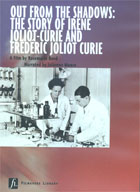
Out From the Shadows: The Story of Irene Joliot-Curie and Frederic Joliot Curie 2009
Distributed by Filmakers Library, 124 East 40th Street, New York, NY 10016; 202-808-4980
Produced by Rosemarie Reed
Directed by Rosemarie Reed
DVD, color, 57 min.
Sr. High - Adult
Chemistry, Science, History, Biography, Women's Studies
Date Entered: 09/20/2010
Reviewed by Eugenia Abbey, Georgia Perimeter CollegeUsing news reels, family home movies and stills, stock footage, dramatization and interviews this biography relates the life and times of Irene Joliot-Curie and her husband, Frederic Joliot- Curie. Though less well-known than her parents, Marie and Pierre Curie, their discoveries were of equal significance. In 1934 they were the first to induce artificial radioactivity, in the process changing one element into another, a discovery for which they were awarded the Nobel Prize for Chemistry the following year. This discovery lead directly to great advances in medicine and science, and ultimately, to their dismay, to the creation and dropping of the atomic bomb. The film portrays their evident happiness together with their children alongside struggles with ill health as well as political unrest and war. Both Irene and Frederic became involved politically in the French anti-Fascist and anti-Nazi movements in the face of the growing threat of Hitler’s Germany. Once France fell Frederic became a leading member of the French Resistance. Between 1945 and 1950 both Joliot-Curies were appointed to prestigious national scientific positions, culminating in the completion in 1948 of the first French nuclear reactor. Long a TB patient, Irene now developed leukemia as had her mother, due to a lifetime of heavy exposure to radiation. She died in 1956. Suffering from hepatitis, Frederic succumbed two years later. This skillfully produced film is a fitting portrayal of two remarkable scientists and patriots who deserve to be better known. Especially powerful are the interviews with their children who recount their memories of their parents and their personalities and struggles. This would be a fine addition to a high school collection where it could be used as a vehicle to inspire the young to pursue a career in science. It is suitable as well for college and public libraries where interest exists or with strong collections in the subject areas.